Mice that flown into space aboard NASA’s space shuttle Atlantis in 2011, returned to Earth with signs of liver disease, according to a researcher at the University of Colorado Anschutz Medical Campus. The investigation comes in a context where space agencies are determining the effects of long-term spaceflight for future missions to the Red Planet.

This is the first time that researchers obtain major information about the impact of spaceflight on the liver. According to Karen Jonscher, study author and associate professor of anesthesiology at CU Anschutz, researchers knew that astronauts usually return to Earth with diabetes-like symptoms.
However, the new study raises concerns about the effects of long-term spaceflights, among astronauts. The mice spend 13.5 days aboard the space shuttle, said CU Anschutz in a press release issued Wednesday.
When the mission returned to Earth in 2011, a team conducted by professor Jonscher collected liver samples from the creature. Results from the analysis demonstrate that the spaceflight activated “specialized liver cells” that may generate scarring and long-term damage to the liver.
“The mice also lost lean muscle mass. We have seen this same phenomenon in humans on bedrest – muscles atrophy and proteins break down into amino acids. The question is, how does that affect your liver?” said Professor Jonscher, adding that damage liver was notable in just 13.5 days.
Study details and other theories
On the way to reach Mars, space researchers have been interested in analyzing the impact of spaceflight on human physiology. They have focused specifically on bone, muscle, brain and cardiovascular function, said CU Anschutz.
Previous theories have suggested that astronauts develop diabetes-like symptoms in the metabolism. The liver plays a fundamental role in diabetes, being the major organ of metabolism. Still, it is not clear if space environment is a dangerous threat for the liver.
The team found out that the mice had a fat storage increase in the liver when comparing it to other mice that stayed on Earth and received the same feed. Moreover, the creature showed a loss of retinol, the equivalent of Vitamin A for animals, combined with changes in the genes responsible for smashing fats.
These signs are typically the result of nonalcoholic fatty liver disease (NAFLD), which can lead to fibrosis. Professor Johnscher said that it usually takes months or years to introduce fibrosis in mice, even when they undergo an unhealthy diet.
If mice show signs of deterioration in the liver just in 13 days, without a change in diet, the impact in humans needs to be analyzed, since the NASA is planning a one-year trip to Mars.
“We need to look at mice involved in longer duration space flight to see if there are compensatory mechanisms that come into play that might protect them from serious damage,” said Professor Johnscher in a statement.
Another theory proposes that stressful conditions related to the reentry to Earth could also have an impact on the liver damage. Researchers have called scientists to conduct further investigations in the area, to better understand if long-term spaceflights can cause advanced hepatic injury.
Source: University of Colorado Anschutz Medical Campus
